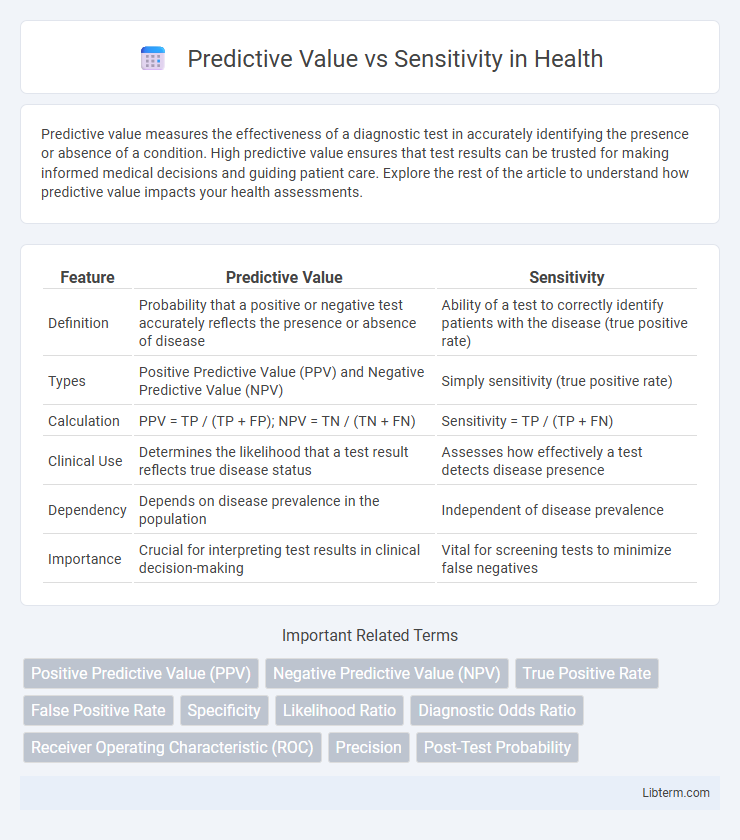Predictive value measures the effectiveness of a diagnostic test in accurately identifying the presence or absence of a condition. High predictive value ensures that test results can be trusted for making informed medical decisions and guiding patient care. Explore the rest of the article to understand how predictive value impacts your health assessments.
Table of Comparison
| Feature | Predictive Value | Sensitivity |
|---|---|---|
| Definition | Probability that a positive or negative test accurately reflects the presence or absence of disease | Ability of a test to correctly identify patients with the disease (true positive rate) |
| Types | Positive Predictive Value (PPV) and Negative Predictive Value (NPV) | Simply sensitivity (true positive rate) |
| Calculation | PPV = TP / (TP + FP); NPV = TN / (TN + FN) | Sensitivity = TP / (TP + FN) |
| Clinical Use | Determines the likelihood that a test result reflects true disease status | Assesses how effectively a test detects disease presence |
| Dependency | Depends on disease prevalence in the population | Independent of disease prevalence |
| Importance | Crucial for interpreting test results in clinical decision-making | Vital for screening tests to minimize false negatives |
Understanding Predictive Value and Sensitivity
Predictive value and sensitivity are essential metrics in evaluating diagnostic tests; sensitivity measures the test's ability to correctly identify true positives, reflecting how well it detects the presence of a condition. Predictive value, which includes positive predictive value (PPV) and negative predictive value (NPV), indicates the probability that a positive or negative test result accurately reflects the presence or absence of disease in a given population. Understanding these parameters helps clinicians assess test performance, optimize diagnostic accuracy, and make informed decisions based on prevalence and clinical context.
Definitions: Predictive Value Explained
Predictive value refers to the probability that a test result accurately reflects the presence or absence of a condition, divided into positive predictive value (PPV) and negative predictive value (NPV). Sensitivity measures the ability of a test to correctly identify true positives, representing the proportion of actual positives detected. While sensitivity focuses on identifying all cases with the condition, predictive value evaluates the reliability of the test results in indicating the true disease status.
Sensitivity: Key Concept in Diagnostic Testing
Sensitivity measures a diagnostic test's ability to correctly identify patients with a disease, reflecting true positive rate. High sensitivity is crucial for screening tests to minimize false negatives and ensure cases are not missed. Unlike predictive value, sensitivity remains constant regardless of disease prevalence, making it essential for evaluating test performance.
Differences Between Predictive Value and Sensitivity
Predictive value measures the probability that a positive or negative test result accurately reflects the presence or absence of disease, while sensitivity quantifies a test's ability to correctly identify true positives among actual cases. Sensitivity is intrinsic to the test's performance and does not depend on disease prevalence, whereas predictive value varies with prevalence and reflects clinical applicability. Understanding the differences between predictive value and sensitivity is crucial for interpreting diagnostic test results within different patient populations.
Importance of Predictive Value in Clinical Settings
Predictive value measures the probability that a patient truly has or does not have a disease based on test results, making it essential for clinical decision-making. Unlike sensitivity, which only assesses a test's ability to identify true positives, predictive value directly impacts patient management by indicating the likelihood of accurate diagnosis. High positive predictive value reduces unnecessary treatments, while high negative predictive value helps avoid missed diagnoses, thereby optimizing clinical outcomes.
Sensitivity’s Role in Disease Screening
Sensitivity measures a test's ability to correctly identify patients with a disease, making it crucial in disease screening to minimize false negatives. High sensitivity ensures that most individuals with the condition are detected early, which is vital for prompt treatment and controlling disease spread. Unlike predictive value, which depends on disease prevalence, sensitivity directly reflects the test's efficacy in recognizing true positive cases.
Factors Influencing Predictive Value and Sensitivity
Predictive value and sensitivity are influenced by key factors such as disease prevalence, test accuracy, and population characteristics. Higher disease prevalence increases the positive predictive value, while sensitivity depends largely on the test's ability to correctly identify true positive cases. Variations in patient demographics and disease spectrum can also alter both sensitivity and predictive value, impacting diagnostic reliability.
Predictive Value vs Sensitivity: Practical Examples
Predictive value measures the probability that a positive or negative test result accurately reflects the presence or absence of a condition, while sensitivity assesses the test's ability to correctly identify true positives. For example, in HIV testing, a highly sensitive test ensures most infected individuals are detected, but the positive predictive value depends on disease prevalence in the population, affecting result reliability. In cancer screening, high sensitivity reduces missed diagnoses, yet predictive value informs clinicians about the likelihood that a positive test indicates actual disease, guiding treatment decisions.
Limitations of Sensitivity and Predictive Value
Sensitivity measures a test's ability to correctly identify true positives but does not account for false positives, limiting its usefulness when disease prevalence is low. Positive predictive value (PPV) indicates the probability that a positive test result reflects actual disease presence, but PPV varies significantly with disease prevalence and may be misleading in populations with rare conditions. Both metrics must be interpreted alongside prevalence and other test parameters to avoid diagnostic errors in clinical decision-making.
Choosing the Right Metric: Predictive Value or Sensitivity?
Choosing between predictive value and sensitivity depends on the clinical context and the goal of the diagnostic test. Sensitivity measures the test's ability to correctly identify true positives, which is crucial for screening diseases where missing cases could have serious consequences. Predictive value, particularly positive predictive value, reflects the probability that a positive test result accurately indicates disease presence, making it essential for confirming diagnoses and guiding treatment decisions.
Predictive Value Infographic

 libterm.com
libterm.com